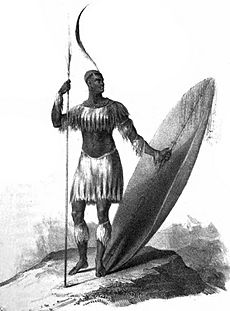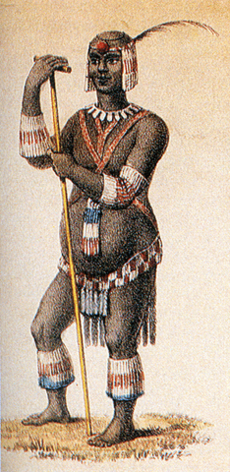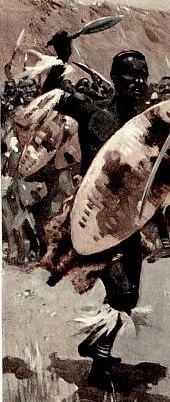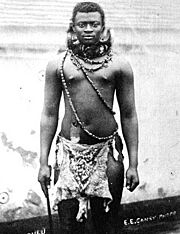Zulu Kingdom facts for kids
Quick facts for kids
Kingdom of Zululand
KwaZulu
|
|||||||||||||
|---|---|---|---|---|---|---|---|---|---|---|---|---|---|
| 1816–1897 | |||||||||||||

Location of the Zulu Kingdom, c. 1890 (red)
(borders in flux) |
|||||||||||||
| Status | Protectorate of the United Kingdom 1887–1897 | ||||||||||||
| Capital | kwaBulawayo; uMgungundlovu; Ulundi | ||||||||||||
| Common languages | isiZulu | ||||||||||||
| Religion | Zulu religion | ||||||||||||
| Government | Monarchy | ||||||||||||
| King | |||||||||||||
|
• 1816–1828
|
Shaka | ||||||||||||
|
• 1828–1840
|
Dingane | ||||||||||||
|
• 1840–1856
|
Mpande | ||||||||||||
| History | |||||||||||||
|
• Death of Dingiswayo
|
1818 | ||||||||||||
|
• Accession of Shaka
|
1816 | ||||||||||||
|
• Battle of Gqokli Hill
|
1818 | ||||||||||||
|
• Battle of Mhlatuze River
|
1820 | ||||||||||||
| 1838 | |||||||||||||
| 1879 | |||||||||||||
|
• British protectorate
|
1887 | ||||||||||||
|
• to Natal
|
1897 | ||||||||||||
| Area | |||||||||||||
| 1822 | 207,000 km2 (80,000 sq mi) | ||||||||||||
| Population | |||||||||||||
|
• 1828
|
250,000 | ||||||||||||
| Currency | Cattle | ||||||||||||
|
|||||||||||||
| Today part of | South Africa | ||||||||||||
The Zulu Kingdom (pronounced ZOO-loo), also known as KwaZulu, was a powerful kingdom in Southern Africa. It was sometimes called the Zulu Empire or the Kingdom of Zululand.
In the 1810s, a strong leader named Shaka created a powerful army. He brought many smaller groups together. This army helped him rule a large area of Southern Africa. This land stretched along the Indian Ocean coast, from the Tugela River in the south to the Pongola River in the north.
Later, in the mid-1800s, a civil war broke out among the Zulu people. This war ended in 1856 with the Battle of Ndondakusuka. In 1879, the British army invaded Zululand, starting the Anglo-Zulu War. The Zulu army won an early victory at the Battle of Isandlwana in January. However, the British fought back and defeated the Zulus in July at the Battle of Ulundi. This battle ended the war. The Zulu Kingdom then became part of the Colony of Natal and later part of the Union of South Africa.
History of the Zulu Kingdom
How Shaka Built the Zulu Kingdom
Shaka was the son of Senzangakhona, who was the Chief of the Zulus. He was born around 1787. Shaka and his mother, Nandi, were sent away by Senzangakhona. They found safety with the Mthethwa people. Shaka became a brave warrior under their leader, Dingiswayo.
When Senzangakhona died, Dingiswayo helped Shaka become the king of the Zulu. After Dingiswayo was killed by Zwide, king of the Ndwandwe, around 1816, Shaka took charge of the whole Mthethwa group.
Shaka's own group was small at first, only a few thousand people. But he brought many nearby groups into his kingdom, making it grow to 45,000 people. He made big changes to the army. He taught new fighting methods, gave tough training, and made soldiers follow strict rules. He also replaced long throwing spears with shorter, more effective stabbing spears. Soldiers were trained as a special army called the amabutho.
Shaka's army survived Zwide's first attack at the Battle of Gqokli Hill in 1818. Within two years, Shaka defeated Zwide at the Battle of Mhlatuze River in 1820. This broke up the Ndwandwe group. Some of the Ndwandwe then attacked other tribes, causing a mass movement of people called Difaqane or Mfecane. Many tribes fled from the fighting. By 1822, Shaka had created an empire covering about 80,000 square miles (207,000 square kilometers). This area stretched from the Pongola to the Tugela Rivers.
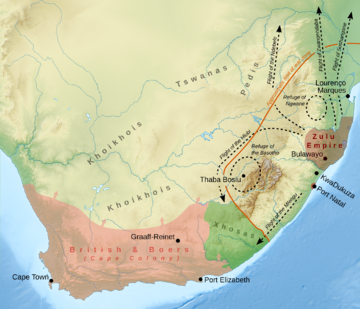
King Dingane's Rule
Shaka was killed by his half-brother, Dingane, in 1828. Dingane then killed his other half-brother, Mhlangana, and took the throne. One of his first acts as king was to kill all his royal relatives. He also killed many of Shaka's old supporters to make sure he was safe as king. The only exception was Mpande, another half-brother, who was seen as too weak to be a threat.
Zulu Conflicts with Voortrekkers
In the Cape Colony, some Dutch settlers, called Boers or Voortrekkers, were unhappy with British rule. From 1836, many of them moved north to create their own independent states. They first met the Ndebele kingdom, and then Dingane's Zulu kingdom.
In October 1837, the Voortrekker leader Piet Retief visited Dingane to discuss a land deal. In November, about 1,000 Voortrekker wagons came down the Drakensberg mountains into what is now KwaZulu-Natal.
Dingane asked Retief to get back some cattle stolen from him by a local chief. Retief and his men did this, returning on February 3, 1838. The next day, a treaty was signed. Dingane gave the Voortrekkers all the land south of the Tugela River to the Mzimvubu River. Celebrations followed.
On February 6, at the end of the celebrations, Retief's group was invited to a dance. They were asked to leave their weapons behind. During the dance, Dingane suddenly shouted, "Bambani abathakathi!" (which means "Seize the wizards" in isiZulu).
Retief and his men were captured, taken to a nearby hill called kwaMatiwane, and killed. Some people believe they were killed for keeping some of the cattle. However, it is more likely that the deal was a trick to defeat the Voortrekkers. Dingane's army then attacked and killed about 250 Voortrekker men, women, and children camped nearby. This place is now called Weenen, which means "to weep" in Dutch.
The remaining Voortrekkers chose a new leader, Andries Pretorius. He led a successful defense against Dingane's forces at the Battle of Blood River on December 16, 1838. In this battle, 15,000 Zulu impis (warriors) attacked 470 Voortrekker settlers led by Pretorius.
King Mpande's Rule
After his defeat, Dingane burned his royal home and fled north. Mpande, the half-brother Dingane had spared, left Dingane with 17,000 followers. Mpande and the Voortrekkers then fought against Dingane. Dingane was killed near the modern Swaziland border. Mpande then became the ruler of the Zulu nation.
After the war against Dingane, the Voortrekkers, led by Pretorius, formed the Natalia republic in 1839. This republic was south of the Tugela River and west of the British settlement of Port Natal (now Durban). Mpande and Pretorius kept peaceful relations. However, in 1842, war started between the British and the Boers. The British took over Natalia. Mpande then supported the British and remained friendly with them.
In 1843, Mpande ordered a purge of people he thought were against him. Many people died, and thousands fled to nearby areas, including the British-controlled Natal. Many of these refugees took their cattle with them. Mpande began raiding the surrounding areas, even invading Swaziland in 1852. But the British made him pull back, which he did soon after.
King Cetshwayo's Rule
At this time, a fight for who would be the next king started between two of Mpande's sons, Cetshwayo and Mbuyazi. This fight ended in 1856 with the Battle of Ndondakusuka, where Mbuyazi was killed. Cetshwayo then began to take over his father's power. When Mpande died of old age in 1872, Cetshwayo became the ruler.
British Takeover of Zululand
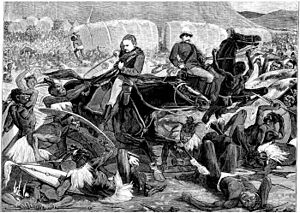
On December 11, 1878, Sir Henry Bartle Frere, a British official, wanted to start a war with the Zulu. Without his government's approval, he gave the Zulu king Cetshwayo an ultimatum. This ultimatum asked the Zulu army to be disbanded and for the Zulus to accept a British resident. These were demands Cetshwayo could not agree to.
British forces crossed the Tugela River at the end of December 1878. At first, the British suffered a major defeat at the Battle of Isandlwana on January 22, 1879. The Zulu army killed over 1,000 British soldiers in one day.
The Zulu army's setup at Isandlwana showed their well-organized fighting system. This system had made the Zulu kingdom successful for many years. This was the worst defeat the British army had ever faced from a native African fighting force. This loss made the British change their war plans. Even though they were outnumbered, the British started winning smaller battles and then larger ones. The fighting ended with the Siege of Ulundi, the Zulu capital city, and the final defeat of the Zulu Kingdom.
Division of the Kingdom and Cetshwayo's Death
Cetshwayo was captured a month after his defeat and sent away to Cape Town. The British divided the Zulu kingdom into 13 smaller areas, each ruled by a "kinglet." Soon, these smaller kingdoms started fighting each other. In 1882, Cetshwayo was allowed to visit England. He met Queen Victoria and other important people. After this, he was allowed to return to Zululand to become king again.
In 1883, Cetshwayo was made king over a smaller area, much less than his original kingdom. Later that year, however, Cetshwayo was attacked at Ulundi by Zibhebhu, one of the 13 kinglets. Cetshwayo was wounded and fled. He died in February 1884, possibly from poison. His son, Dinuzulu, who was 15, then became king.
King Dinuzulu's Rule and Exile
Dinuzulu made a deal with the Boers, promising them land if they helped him. The Boers were led by Louis Botha. Dinuzulu and the Boers defeated Zibhebhu in 1884. The Boers were given about half of Zululand as farms and formed their own independent republic called Vryheid.
This worried the British because they did not want the Boers to have access to a harbor. So, the British took over Zululand in 1887. Dinuzulu later got involved in more conflicts with rivals. In 1906, Dinuzulu was accused of being behind the Bambatha Rebellion. He was arrested and put on trial by the British for "high treason and public violence." In 1909, he was sentenced to ten years in prison on St Helena island.
When the Union of South Africa was formed, Louis Botha became its first prime minister. He arranged for his old ally Dinuzulu to return to South Africa. Dinuzulu lived in exile on a farm in the Transvaal, where he died in 1913.
Dinuzulu's son, Solomon kaDinuzulu, was never officially recognized as the Zulu king by South African authorities. He was only seen as a local chief. However, many chiefs, thinkers like John Langalibalele Dube, and ordinary Zulu people saw him as their king. In 1923, Solomon started an organization called Inkatha YaKwaZulu to support his claim to the throne. This group later became inactive but was restarted in the 1970s by Mangosuthu Buthelezi. In December 1951, Solomon's son Cyprian Bhekuzulu kaSolomon was officially recognized as the Paramount Chief of the Zulu people. However, the real power over ordinary Zulu people was held by South African government officials who worked through local chiefs.
Recent History of Zululand
KwaZulu Bantustan
KwaZulu was a special area in South Africa. The apartheid government created it as a semi-independent homeland for the Zulu people. Its capital was moved from Nongoma to Ulundi in 1980.
Chief Mangosuthu Buthelezi, who was part of the Zulu royal family and head of the Inkatha Freedom Party (IFP), led KwaZulu until it was ended in 1994. It was then combined with the surrounding Natal to form the new province of KwaZulu-Natal.
The name KwaZulu means "Place of Zulus" or "Zululand."
Modern Zululand Today
The area that was once the Zulu Kingdom is now part of South Africa's KwaZulu-Natal province. This province is led by King MisiZulu ka Zwelithini. A large part of this territory is made up of wildlife reserves. Tourism is a major source of income here, as the area is known for its savanna-covered hills.
It is home to a WWF project called "The Black Rhino Range Expansion Project." This project helps reintroduce Black Rhinoceros into the Zululand Rhino Reserve (ZRR). The ZRR is a large reserve of 20,000 hectares (about 77 square miles). It includes 15 farms that have removed their fences to help with conservation efforts. The Zulu royal family still performs many important ceremonial duties today.
See also
- Zulu military system
- Impi
- Zulu Civil War
- Anglo-Zulu War
- List of Zulu kings
- Postage stamps and postal history of Zululand
- Nguni stick-fighting


